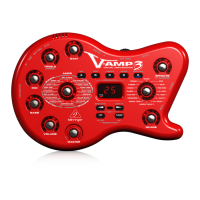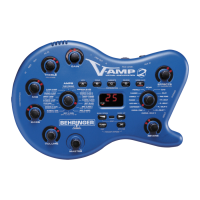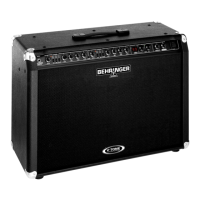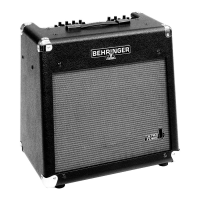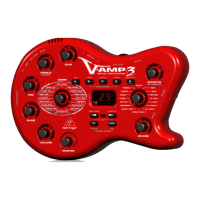17
V-AMP
5.3 Storing presets
To save your edits keep the preset button of your choice pressed for about 2 seconds, thus overwriting the
previous settings (button LED lights up permanently).
+ Of course, you dont have to save your edits in the same memory location as the original
preset. To select a different memory location use the arrow keys (BANK UP and BANK DOWN)
to recall a preset bank. Then, press the preset button of your choice for about 2 seconds to
store your settings. In this way, you can edit a preset originally stored in, for example, bank 5
and memory location D, to e.g. bank 6, preset A.
5.4 Edit cancel / restoring a single original artist preset
When you have edited a preset and find that you dont like what youve changed, you can cancel your edits.
We assume that you have selected and edited preset C (button LED flashes), but wish to recall the original
settings: Simply select another preset; now, when you recall the previously edited preset (here: C), all edits
have been canceled. However, when you keep both arrow keys pressed after editing until the display reads
Pr, you can recall the original artist preset originally stored in the selected memory location. Dont forget to
store this preset by pressing the preset button for about 2 seconds.
5.5 Restoring all original artist presets
Do as follows to restore all factory presets: Keep the buttons D and E pressed, before you switch on your
V-AMP. After power-up the display reads CL. Release the two keys and press both arrow keys to overwrite all
user-edited presets and replace them by the original artist presets.
6. TUNER
Press the TUNER button to activate the built-in tuner.
6.1 Tuning a guitar
The chromatic tuner automatically detects the frequency of all basic guitar notes, for example, A string =
440 Hz. When you connect your guitar to the V-AMP and play an open string, the tuner tries to detect and
display the note. Since the tuner uses a chromatic scale, it also detects semi-tones, which are preceded by a
b in the display.
It may happen though that a note displayed as, for example, a is slightly out of tune, which is shown by at
least one of the four arrow LEDs at the bottom edge of the display lighting up. Sometimes, even two LEDs
may light up, which indicates that the pitch of the tone currently played is just in between the pitches represented
by the two single LEDs. When the circular tuner LED in the middle lights up, the tone played is in tune.
6.2 Adjusting reference pitch a
To give you maximum freedom when tuning your guitar, you can change the preset reference pitch a. Just to
make things clear, lets discuss this in some more detail.
The so-called concert pitch a has been raised repeatedly over time: For example, the tuning forks used by
Bach, Handel or Mozart were tuned to 415, 420 or 421 Hz respectively (oscillations per second). Today,
orchestras tune to a = 444 Hz, and the Berlin Philharmonic Orchestra tries to lead the pack by using a
concert pitch of 447 Hz.
The reference pitch a in your V-AMP is set to 440 Hz. If you wish to play with a big orchestra who tune their
instruments to 444 Hz, you will need a function that allows you to change the reference pitch a of your
V-AMP. Activate this function as follows: In PLAY mode, activate the tuner by pressing the TUNER button,
then press both arrow keys to enter SETUP mode. The display reads 40, which corresponds to 440 Hz. Use
the arrow keys to raise or lower the reference pitch by up to 15 Hz. The display only reads the two last figures
of the basic tone, because the first figure is always 4. For example, when you start with a reference pitch of
6. TUNER

